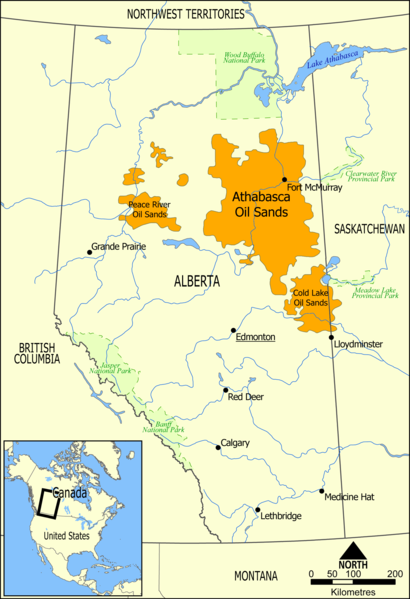Some background about Athabasca oil sands: located in a remote part of Western Canada, the area has been in production since 1967 and a meteoric rise in oil price over the last decade have made it an attractive place for oil companies to set up shop there. Production increased from 760,000 barrels per day in 2005 (source: Wikipedia) to 1.6 million in 2011, and is projected to reach 3 million by 2020.
Unlike conventional crude, which is usually found and produced from an underground reservoir, oil sands (a mixture of bitumen, water, clay and sand) can be dug out with a shovel--literally:

It then goes to a refinery where the bitumen is cooked out of the sandy mixture and upgraded to usable crude oil. This type of production costs more than conventional oil production, mainly because a lot of natural gas is needed to heat the bitumen. A more advanced method is to inject steam into the oil sands, which makes it possible for the oil to be drained out of the sands. This is called SAGD (Steam Assisted Gravity Drainage).
What does this all cost? From the Wikipedia article:
In mid-2006, the National Energy Board of Canada estimated the operating cost of a new mining operation in the Athabasca oil sands to be C$9 to C$12 per barrel, while the cost of an in-situ SAGD operation (using dual horizontal wells) would be C$10 to C$14 per barrel.[82] This compares to operating costs for conventional oil wells which can range from less than one dollar per barrel in Iraq and Saudi Arabia to over six in the United States and Canada's conventional oil reserves.
The capital cost of the equipment required to mine the sands and haul it to processing is a major consideration in starting production. The NEB estimates that capital costs raise the total cost of production to C$18 to C$20 per barrel for a new mining operation and C$18 to C$22 per barrel for a SAGD operation. This does not include the cost of upgrading the crude bitumen to synthetic crude oil, which makes the final costs C$36 to C$40 per barrel for a new mining operation.So what happens when oil prices go down? This article says what I've been thinking:
The recent steep drop in crude-oil prices isn't good news for Canada's oil-sands industry, which boasts large reserves but requires high up-front costs for development.
With oil futures prices dropping more than 30% since April from above $110 a barrel to below $80 a barrel Tuesday, profits will be squeezed at several projects and some under construction may be halted if they no longer make economic sense.What about costs? In 2011, They're going up:
Canadian Oil Sands, which has a 37 per cent interest in the sprawling Syncrude development north of Fort McMurray, Alta., said its results were helped by higher overall oil prices, although production dropped and operating expenses rose. [...]
In the quarter, operating costs were $37.07 a barrel, compared with $30.93 a year earlier.Of course, these are just the costs for one company but I'm confident that other's are in the same range. Note that the operating costs mentioned in the Wikipedia article are in the $9-$12 range, so costs have gone up about fourfold over the past five years. (Also note that the costs are in Canadian dollars, making them even higher in US$ terms.) If capital costs have stayed the same, that makes the operational + capital costs (before upgrading) to about US$50/barrel. I'm making a wild guess here but I see $70 in ops + capital + upgrading costs as a lower limit. And then you still need to transport it to the end user...
So at a current WTI price of $85 it's barely profitable to invest in new projects. But the bigger problem is volatility. If you were sure that costs and revenue per barrel would remain constant, you could expect a long-term profit. However both are subject to volatility as they depend on the natural gas price, construction materials, crude oil demand etc. The current situation is that, barrel for barrel, costs are going up and revenues are declining fast.
That leads me to take a look at the bigger picture. The world economy has been in a rough patch for the last four years and this has its effects on crude oil demand--no economic growth, no demand, prices go down. In 2009, the price for WTI, the global oil price benchmark, hit US$40 a barrel, after hitting $147 about six months earlier. The world economy was stuck in reverse after a huge financial crisis the year before and demand plummeted.
This could happen again in 2011: just follow the news about U.S. and European debt crises and their knock-on effect on the economy. Already the WTI price is halfway down to the 2009 lows.
Although back then it didn't stop oil sands producers from operating, it made them reluctant to invest in new projects until the price went back up. If oil hits $40 again--which I think is likely--producers will scratch their head once more and at least take a hard look at their Athabasca expansion plans which, at (my speculative guess of) $70 total cost per barrel, make no business sense.
The big question is how future technological developments and efficiency improvements will be able to bring costs down. For now though, I believe that high costs and high volatility makes it challenging to expand in Athabasca with confidence.

No comments:
Post a Comment